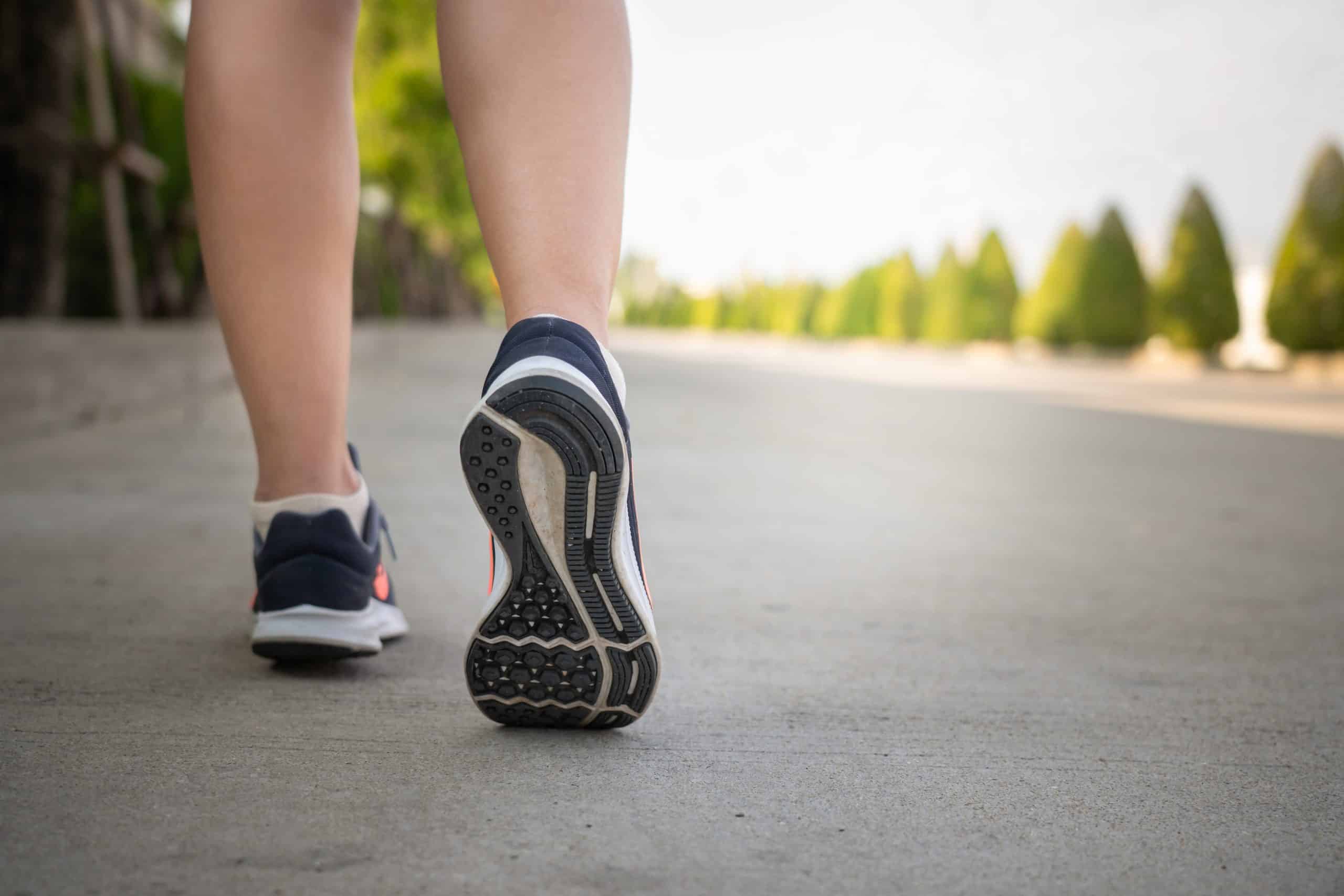If I walk for 2 miles each day, will I lose weight?” Yes, you may; because walking burns calories. Two miles might not seem like much, but it’s a step in the direction towards a healthier lifestyle. The number of calories burned can vary based on factors such as your weight, pace, and the terrain you’re traversing. However, every step counts when it comes to achieving your weight loss goals.
In this article we will go into how many calories are burned from walking 2 miles and how this simple activity can be a key factor in your weight loss journey. We’ll also cover how to make the most of this simple exercise.
How Many Calories Does a 2 Mile Walk Burn?
The amount of calories burned from walking 2 miles depends on your body weight and speed. Generally, a person weighing 125-185 pounds can burn about 100-170 calories in 30 minutes while walking two miles at an average pace (3). If you weigh less than that you’ll burn fewer calories; conversely, if you weigh more than that, then you’ll burn more calories.
The terrain is also a factor in the number of calories burned. Walking on flat surfaces requires less energy than climbing hills or stairs, as it takes more effort to move your body uphill.
Additionally, the speed at which you walk can have an impact on how many calories you use up; walking faster or running will burn more calories than walking at a slower pace. The distance matters too. The calories burned walking 1 mile will be less than those burned walking 2 miles.
Read More: How Can Walking Come In Handy If You Want to Lose Weight
Can I Lose Weight By Walking 2 Miles a Day?
Achieving your weight loss goals is all about creating a calorie deficit in which you are consuming fewer calories than you’re burning or vice versa (9). Walking two miles each day can be an easy way to create this balance, as it’s one of the most convenient and accessible forms of exercise.
Think about it; when you walk two miles each day that’s an additional 180-260 calories burned in 20 minutes. When done consistently over the course of a month, this could equate to up to 3,000 calories! A deficit of around 3,500 calories each week is said to result in 1 pound of weight loss, which proves how small changes can add up.
Note that while walking can be beneficial for weight loss, it should be done in conjunction with healthy eating; otherwise, the calorie deficit will not be created and you won’t see results.
It’s best to pick a walking plan and stick to it. Instead of walking 2 miles a day you can opt for a 10,000 or 20,000 steps a day weight loss program which covers a longer distance.
In addition, walking has other benefits that indirectly aid weight loss. Regular physical activity like walking can boost your metabolism, which increases the rate at which your body burns calories even when at rest (14)
Walking can also reduce cravings for unhealthy foods such as sugary snacks and improve your mood, both of which can make it easier to maintain a healthy diet (2) (7) .
Will Walking 2 Miles a Day Help Lose Belly Fat?
Walking can indeed help you lose belly fat, including walking 2 miles a day (13). The key lies in creating a consistent calorie deficit, and walking is an effective way to burn extra calories.
When you walk, your body uses energy, and if this energy deficit supports a consistent calorie deficit, your body will begin to use stored fat as fuel. This includes the fat stored in your belly. The more consistently you walk, the more this process goes into effect.
However, the relationship between walking and belly fat loss is more complex than just burning calories. Walking also has an impact on your metabolism. Regular physical activity such as walking can boost your metabolic rate, meaning you’ll burn more calories even when you’re not exercising (14).
Additionally, walking can help build lean muscle. While it’s not as effective as strength training for muscle building, it does contribute to overall muscle mass. More muscle means a higher resting metabolic rate, so you’ll burn more calories even when not walking.
Walking also has other indirect benefits that can aid in belly fat loss. It’s a relatively low-stress exercise, which means it can be easier to stick with a walking routine compared to more intense workouts. Regular walking can improve your mood and reduce stress levels, which can help prevent emotional eating and make it easier to maintain a healthy diet.
Walking for belly fat loss is most effective when combined with other healthy habits (20). A balanced diet is crucial, plus incorporating strength training into your routine can accelerate the process.
Can You Get In Shape Walking 2 Miles a Day?
“Getting in shape” generally refers to improving your overall physical fitness and health, which can include increasing cardiovascular endurance, building muscle strength, enhancing flexibility, losing weight, and reducing body fat. It’s a holistic concept that takes into account several aspects of physical well-being.
Improvement in Cardiovascular Health
Walking 2 miles a day can positively contribute to your cardiovascular health (19). When you walk, your heart rate increases, pumping more blood to your muscles and back to your lungs.
Over time, this can strengthen your heart muscle, reduce the risk of heart disease, and improve your overall endurance. This increased endurance can make daily activities easier and improve your performance in other types of exercise, contributing to overall physical fitness.
Aid in Weight Management
Walking is an excellent way to burn calories, and as discussed earlier, burning more calories than you consume leads to weight loss (13). Given that maintaining a healthy weight is an essential part of being in shape, walking 2 miles a day can definitely contribute to this goal.
Regular walking can also help boost your metabolism, which means you may continue to burn calories even when at rest, further aiding in weight management.
Increase in Muscle Strength and Endurance
While walking is not a strength training exercise, it does engage several muscle groups including your legs, hips and abdomen. Consistently walking 2 miles a day can help tone these muscles and increase your muscular endurance, which is the ability of your muscles to perform physical tasks over time without becoming fatigued.
Greater muscle strength and endurance can improve your overall physical fitness and make daily tasks easier (12).
Read More: A 21-Day Walking Plan For Fat Loss
Enhancement of Mental Health
Being in shape isn’t just about physical fitness – mental well-being plays a crucial role too. Regular exercise like mindful walking has been shown to reduce symptoms of depression and anxiety, improve mood, and boost self-esteem (7). These benefits can make it easier to maintain a regular exercise routine and make healthy dietary choices, both of which are important for getting and staying in shape.
Promotion of Flexibility and Balance
Walking is a weight-bearing exercise, which means it can help improve balance and coordination. Regular walking can also promote joint health and flexibility, especially in your lower body (18). While the impact on flexibility isn’t as significant as with exercises like yoga or stretching, it still contributes to your overall physical fitness.
Boost in Immune System Functionality
Walking regularly can have a positive impact on your immune system. Regular moderate-intensity exercise such as walking can stimulate your immune system, enhancing your body’s ability to fight off infections and diseases (4). This may translate to fewer colds, bouts of flu, and other illnesses, keeping you healthier and more capable of maintaining a consistent exercise routine.
Promotion of Better Sleep
Regular walking can contribute towards better sleep patterns. Physical activity, in general, is known to improve sleep quality (16). Better sleep can lead to improved energy levels, better mood, and enhanced performance in daily activities and exercise routines – all contributing to overall physical fitness (17).
Improvement in Bone Density
Walking is a weight-bearing exercise, which means it helps in maintaining healthy bone density. Regular walking can help slow down bone mineral density loss, reducing the risk of fractures and osteoporosis in the long run (8). Healthy bones support a more active lifestyle, which is key to staying in shape.
Enhancement in Digestive Health
Regular walking can aid digestion by helping to move food through the digestive system (6). Good digestive health is crucial for overall well-being, absorbing essential nutrients, supporting regular bowel movements and digestive comfort, and furthermore, managing weight and overall health (1).
How to Make Your 2-Mile Walk as Efficient, and Enjoyable As Possible?
Elevating a simple exercise like walking involves optimizing it for maximum physical benefits while also ensuring it’s an enjoyable experience. Here are some ways to make your 2-mile walk as efficient and enjoyable as possible:
Choosing the Right Walking Route
Your walking route can significantly influence both the efficiency and enjoyment of your walk. A route with varying terrain, such as hills or uneven surfaces, can increase the intensity of your walk and engage different muscle groups, making your workout more effective. Calories burned walking 5 km uphill are higher compared to those walking on even terrain.
On the other hand, a scenic route can make your walk more enjoyable and motivate you to keep going. If possible, try to find a route that combines both challenging terrain and beautiful scenery.
Incorporating Interval Training
Interval training involves alternating between periods of high-intensity exercise and low-intensity recovery. In the context of walking, this could mean alternating between fast-paced walking and slower, more leisurely walking. This method can make your workout more efficient by increasing the amount of calories burned. It also adds variety to your walk, which can make it more enjoyable.
Using Proper Walking Technique
Proper walking technique can make your walk more efficient by allowing you to move faster and easier. This includes maintaining good posture, swinging your arms naturally, and taking shorter, quicker steps. Practicing proper technique can also reduce the risk of injury, making your walk safer and more enjoyable.
Read More: 16 Benefits Of Full-Body Workouts: What Can A Compound, Full-Body Workout Do For You?
Listening to Music or Podcasts
Listening to music or podcasts during your walk can make the time pass more quickly and make your exercise more enjoyable. You could listen to upbeat music to motivate you to walk faster, or educational podcasts to learn something new while you exercise. Just make sure to keep the volume at a safe level so you can still hear traffic and other important sounds.
Wearing Comfortable Clothing and Footwear
Wearing comfortable clothing and footwear will make your walk more enjoyable by preventing discomfort and potential injuries. Choose clothing that is appropriate for the weather and made from breathable materials. Your shoes should be comfortable and provide good support.
Practicing Mindfulness
Practicing mindfulness during your walk can make it more enjoyable by helping you to appreciate the present moment. Try to pay attention to the sensations in your body, the sounds around you, and the sights you pass. This can transform your walk into a form of meditation, reducing stress and improving your mental well-being.
Incorporating Strength Training
Adding elements of strength training to your walk can enhance its physical benefits (15). This could involve carrying light weights or doing bodyweight exercises, such as lunges or squats, during your walk.
By incorporating strength training, you can build muscle and increase your metabolic rate, further enhancing your fitness and weight management. Remember to maintain proper form during these exercises to prevent injury.
Emphasizing Hydration
Staying hydrated while walking is critical. Even light exercise can lead to sweat loss, and it’s important to replace those fluids to maintain energy levels and prevent dehydration.
Carrying a water bottle with you can ensure you have easy access to hydration. Plus, staying well-hydrated can also help control hunger, aiding in weight management (11).
Including Power Walking
Power walking is a style of walking performed at a higher intensity than regular walking. It involves exaggerated arm swinging and fast steps, which can boost your heart rate and burn more calories. Incorporating intervals of power walking into your regular walk will contribute to improved cardiovascular fitness and increased calorie burn, making your walk more efficient.
Practicing Deep Breathing
Deep breathing during your walk can has multiple benefits. It can help you manage stress, enhance your lung capacity, and oxygenate your blood more efficiently (5).
Try to consciously take deep, slow breaths during your walk, filling your lungs completely and then slowly exhaling. This practice can add a calming element to your walk and improve your overall health.
Using a Pedometer or Fitness Tracker
A pedometer or fitness tracker can make your walks more efficient by helping you track your pace, distance, and calories burned. This information could motivate you to push yourself harder and accomplish more during your walks. Additionally, seeing your progress can make your walks more satisfying and enjoyable.
Implementing a Reward System
Finally, consider implementing a reward system for reaching walking goals. This could involve treating yourself to something you enjoy after a certain number of successful walks or milestones reached. A reward system can make your walks more enjoyable by providing additional motivation and making your exercise routine feel more like a game than a chore.
FAQs
How Far Do You Have to Walk to Burn 1000 Calories?
The distance you need to walk to burn 1000 calories depends on several factors, including your weight, height, walking pace, and terrain. However, using a walking calories calculator, you can estimate that a person weighing around 160 pounds would need to walk approximately 7-8 miles at a brisk pace to burn around 1000 calories.
What Happens If You Walk for 1 Hour Every Day?
If you walk for 1 hour every day, you will likely see several health benefits. You will be burning a significant number of calories – for instance, a “calories burned walking 1 hour” calculation might show you’re burning around 200-400 calories, depending on your weight and pace. This regular physical activity could lead to weight loss, improved cardiovascular health, better mood, stronger muscles and bones, and a lower risk of chronic diseases.
What Happens If You Walk Every Day for a Month?
If you walk every day for a month, the benefits of daily exercise will start to accumulate. You may notice weight loss, particularly if you create a calorie deficit by eating a balanced diet.
For example, if you were to walk 10,000 steps every day for a month, a “how many calories does walking 10,000 steps burn” calculation could suggest you’d burn around 2,000 to 3,500 extra calories per week, which could lead to weight loss over time.
What Is the Best Time to Walk to Lose Weight?
The best time to walk to lose weight is whenever you can consistently fit it into your schedule. That said, some research suggests that exercising in a fasted state before breakfast can help your body burn more fat. However, it’s not the only effective method for weight loss and the most important factor is consistency, so choose a time that works best for you.
Is Walking a Day Enough Exercise?
Walking every day can certainly contribute to your overall physical activity, but whether it’s enough exercise depends on your personal fitness goals and health needs.
For general health benefits, the Centers for Disease Control and Prevention (CDC) recommends adults get at least 150 minutes of moderate-intensity aerobic activity, like brisk walking, or 75 minutes of vigorous-intensity activity, like running, per week (10).
How Much Weight Can I Lose in 1 Month by Walking?
The amount of weight you can lose in a month by walking depends on how much you walk and the intensity of your walks. It also depends on your diet.
If you maintain a healthy, balanced diet and walk for 1 hour each day at a brisk pace, you could potentially lose between 4 and 8 pounds in a month. However, individual results vary, and it’s important to aim for sustainable, healthy weight loss of 1-2 pounds per week.
The Bottom Line
Calories burned walking 2 miles can be an effective way to manage weight and improve overall fitness. By incorporating mindful practices, strength training, hydration, power walking, deep breathing, tracking devices, and a reward system into your walk routine, you can make your walks more enjoyable while achieving optimal health benefits.
DISCLAIMER:
This article is intended for general informational purposes only and does not serve to address individual circumstances. It is not a substitute for professional advice or help and should not be relied on for making any kind of decision-making. Any action taken as a direct or indirect result of the information in this article is entirely at your own risk and is your sole responsibility.
BetterMe, its content staff, and its medical advisors accept no responsibility for inaccuracies, errors, misstatements, inconsistencies, or omissions and specifically disclaim any liability, loss or risk, personal, professional or otherwise, which may be incurred as a consequence, directly or indirectly, of the use and/or application of any content.
You should always seek the advice of your physician or other qualified health provider with any questions you may have regarding a medical condition or your specific situation. Never disregard professional medical advice or delay seeking it because of BetterMe content. If you suspect or think you may have a medical emergency, call your doctor.
SOURCES:
- ‘Gut health’: a new objective in medicine? (2011, biomedcentral.com)
- Acute Effects of Brisk Walking on Sugary Snack Cravings in Overweight People, Affect and Responses to a Manipulated Stress Situation and to a Sugary Snack Cue: A Crossover Study (2015, journals.plos.org) c
- Calories burned in 30 minutes of leisure and routine activities(2021, health.harvard.edu)
- Effect of Exercise Intensity on Cell-Mediated Immunity (2021, mdpi.com)
- Effects of Diaphragmatic Breathing on Health: A Narrative Review (2020, mdpi.com)
- Exercise and gastrointestinal function and disease: an evidence-based review of risks and benefits (2003, cghjournal.org)
- Exercise for Mental Health (2006, ncbi.nlm.nih.gov)
- Exercise on Bone Density in Osteoporotic Patients (2018, hindawi.com)
- Fat loss depends on energy deficit only, independently of the method for weight loss (2007, pubmed.ncbi.nlm.nih.gov)
- How much physical activity do adults need? (2022, cdc.gov)
- Increased Hydration Can Be Associated with Weight Loss (2016, frontiersin.org)
- Musculoskeletal fitness, health outcomes and quality of life (2001, pubmed.ncbi.nlm.nih.gov)
- Pattern of Daily Steps is Associated with Weight Loss: Secondary Analysis from the Step‐Up Randomized Trial (2019, onlinelibrary.wiley.com)
- Physical Activity Plays an Important Role in Body Weight Regulation (2011, hindawi.com)
- Strength training: Get stronger, leaner, healthier (2023, mayoclinic.org)
- The bidirectional relationship between exercise and sleep: Implications for exercise adherence and sleep improvement (2015, ncbi.nlm.nih.gov)
- The Extraordinary Importance of Sleep (2018, ncbi.nlm.nih.gov)
- Walking to health (1997, pubmed.ncbi.nlm.nih.gov)
- Walking – the first steps in cardiovascular disease prevention (2011, ncbi.nlm.nih.gov)
- Weight-Loss and Maintenance Strategies (2004, ncbi.nlm.nih.gov)














